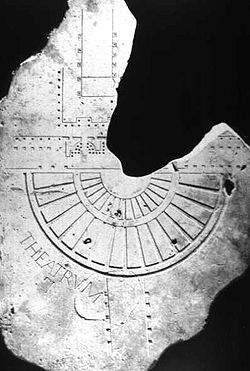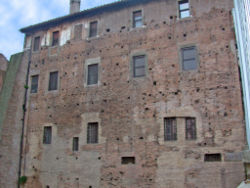
Forma Urbis Romae
Encyclopedia


Map
A map is a visual representation of an area—a symbolic depiction highlighting relationships between elements of that space such as objects, regions, and themes....
of ancient Rome
Rome
Rome is the capital of Italy and the country's largest and most populated city and comune, with over 2.7 million residents in . The city is located in the central-western portion of the Italian Peninsula, on the Tiber River within the Lazio region of Italy.Rome's history spans two and a half...
, created under the emperor Septimius Severus
Septimius Severus
Septimius Severus , also known as Severus, was Roman Emperor from 193 to 211. Severus was born in Leptis Magna in the province of Africa. As a young man he advanced through the customary succession of offices under the reigns of Marcus Aurelius and Commodus. Severus seized power after the death of...
between 203 and 211. It originally measured 18 m (60 ft) wide by 13 m (45 ft) high and was carved into 150 marble slabs mounted on an interior wall of the Temple of Peace
Santi Cosma e Damiano
The basilica of Santi Cosma e Damiano is a church in Rome, Italy, located in the Roman Forum. It is one of the ancient churches called tituli, of which cardinals are patrons as deacons: the Cardinal Deacon of the Titulus Ss. Cosmae et Damiani is Giovanni Cheli...
.
Created at a scale of approximately 1 to 240, the map was detailed enough to show the floor plans of nearly every temple, bath, and insula
Insulae
In Roman architecture, an insula was a kind of apartment building that housed most of the urban citizen population of ancient Rome, including ordinary people of lower- or middle-class status and all but the wealthiest from the upper-middle class...
in the central Roman city. The boundaries of the plan were decided based on the available space on the marble, instead of by geographical or political borders as modern maps usually are.
The Plan was gradually destroyed during the Middle Ages
Middle Ages
The Middle Ages is a periodization of European history from the 5th century to the 15th century. The Middle Ages follows the fall of the Western Roman Empire in 476 and precedes the Early Modern Era. It is the middle period of a three-period division of Western history: Classic, Medieval and Modern...
, with the marble stones being used as building materials or for making lime. In 1562, the young antiquarian sculptor Giovanni Antonio Dosio
Giovanni Antonio Dosio
Giovanni Antonio Dosio was an Italian architect and sculptor.He was born in San Gimignano. A student of Ammanati, with whom he realized the Villa dell'Ambrogiana, Dosio worked primarily in Rome and Florence , with some commissions that took him to Naples.During his early years in Rome, where he...
excavated fragments of the Forma Urbis from a site near the Church of SS. Cosma e Damiano
Santi Cosma e Damiano
The basilica of Santi Cosma e Damiano is a church in Rome, Italy, located in the Roman Forum. It is one of the ancient churches called tituli, of which cardinals are patrons as deacons: the Cardinal Deacon of the Titulus Ss. Cosmae et Damiani is Giovanni Cheli...
, under the direction of the humanist condottiere Torquato Conti, who had purchased excavation rights from the canons of the church. Conti made a gift of the recovered fragments to Cardinal Alessandro Farnese, who entrusted them to his librarian Onofrio Panvinio
Onofrio Panvinio
The erudite Augustinian Onofrio Panvinio or Onuphrius Panvinius was an Italian historian and antiquary, who was librarian to Cardinal Alessandro Farnese....
and his antiquarian Fulvio Orsini
Fulvio Orsini
Fulvio Orsini was an Italian humanist, historian, and archaeologist. He was a scion of the Orsini family, one of the oldest, most illustrious, and for centuries most powerful of the Roman princely families, whose origins, when stripped of legend, can be traced back to a certain Ursus de Paro,...
. Little interest seems to have been elicited by the marble shards.
In all about 10% of the original surface area of the plan has since been recovered, in the form of over one thousand marble fragments, which are kept in the Palazzo dei Conservatori of the Capitoline Museums
Capitoline Museums
The Capitoline Museums are a group of art and archeological museums in Piazza del Campidoglio, on top of the Capitoline Hill in Rome, Italy. The museums are contained in three palazzi surrounding a central trapezoidal piazza in a plan conceived by Michelangelo Buonarroti in 1536 and executed over...
.
Projects
Piecing together the surviving fragments of the plan is an activity that has engrossed scholars for centuries. RenaissanceRenaissance
The Renaissance was a cultural movement that spanned roughly the 14th to the 17th century, beginning in Italy in the Late Middle Ages and later spreading to the rest of Europe. The term is also used more loosely to refer to the historical era, but since the changes of the Renaissance were not...
scholars managed to match and identify around 250 of the pieces, usually by recognizing famous landmarks such as the Colosseum
Colosseum
The Colosseum, or the Coliseum, originally the Flavian Amphitheatre , is an elliptical amphitheatre in the centre of the city of Rome, Italy, the largest ever built in the Roman Empire...
and the Circus Maximus
Circus Maximus
The Circus Maximus is an ancient Roman chariot racing stadium and mass entertainment venue located in Rome, Italy. Situated in the valley between the Aventine and Palatine hills, it was the first and largest stadium in ancient Rome and its later Empire...
. A research project at Stanford University
Stanford University
The Leland Stanford Junior University, commonly referred to as Stanford University or Stanford, is a private research university on an campus located near Palo Alto, California. It is situated in the northwestern Santa Clara Valley on the San Francisco Peninsula, approximately northwest of San...
in 2002 had some success in reassembling the fragments with pattern recognition algorithms.
External links
- Stanford Digital Forma Urbis Romae Project
- BBC news
- Rodolfo Lanciani, Forma Urbis Romae 1893-1901 Lanciani's own unsurpassed map of ancient Rome, printed in 46 separate plates

